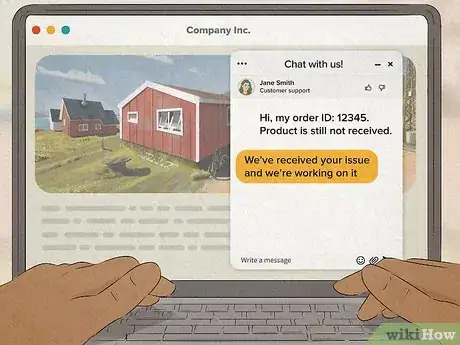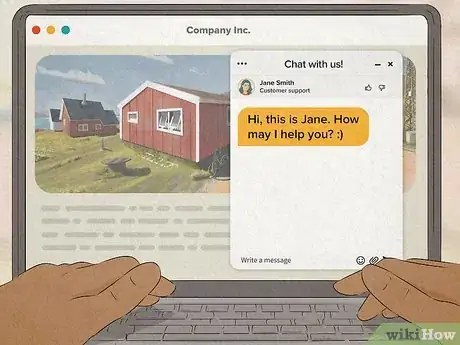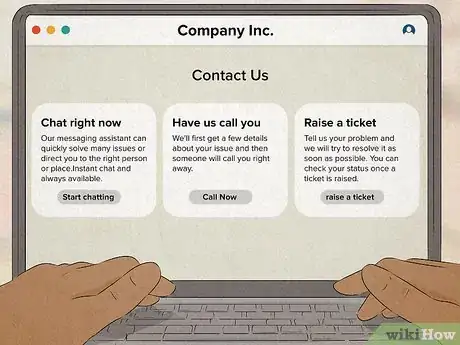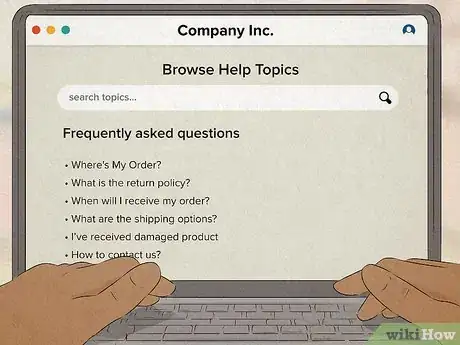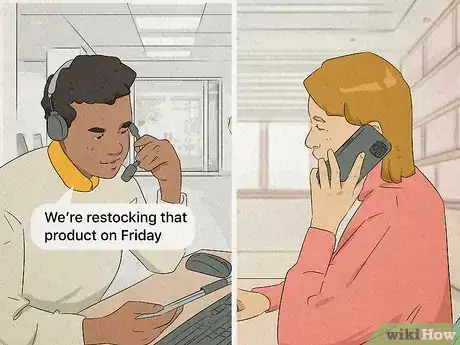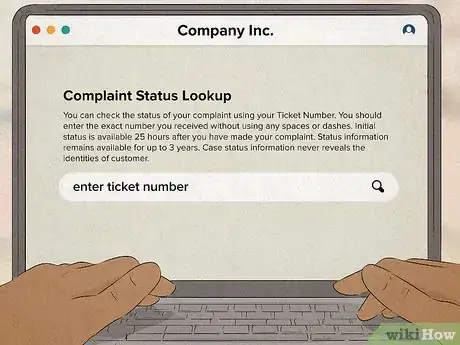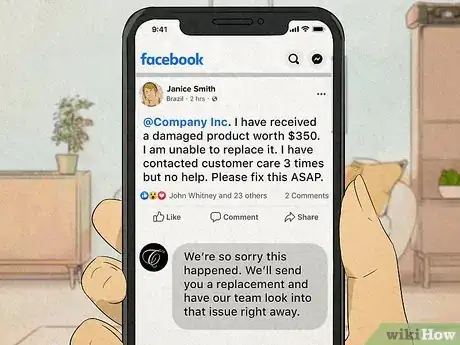This article was co-authored by Art Lewin and by wikiHow staff writer, Kira Jan. Art Lewin is an Entrepreneur based in Los Angeles, California. He specializes in business, sales, marketing, and real estate investing. Art is the CEO and Founder of four companies based in Los Angeles: Art Lewin Bespoke, Healthy Choice Labs, SFR Properties, and Professional Business Network (PBN). Art is known globally for his exclusive custom-made and ready-to-wear business wear designs. Some of his notable clients include royal family members, politicians, and Hollywood stars including Hugh Hefner, Sylvester Stallone, Johnny Carson, Steve Allen, and William Shatner.
There are 20 references cited in this article, which can be found at the bottom of the page.
This article has been viewed 6,681 times.
The last thing you want to hear is that a customer isn’t happy with your company’s product or service. Dealing with consumer complaints can be time-consuming, frustrating, and even costly. But here’s the secret, no matter the size of your business: 96% of customers identify customer service as a key factor when they choose whether or not to be loyal to a brand.[1] X Research source So how can you efficiently handle complaints while elevating your service from “satisfactory” to “excellent?” We’ve identified the top 15 customer complaints so you’ll be able to anticipate, prevent, and resolve issues to deliver winning customer service.
Steps
Long wait times
-
Improve your hold times and fix slow responses for online support.[2] X Research source Customers want to have their issues acknowledged and resolved as quickly as possible. About 60% of customers state that they want their issue resolved within 10 minutes.[3] X Research source If that sounds fast, check out solutions for optimizing your response time:
- The quick fix: Regularly update customers about the status of their complaint. Send a simple message as soon as you receive a complaint (ex. “We’ve received your issue and we’re working on it”).
- The outside-the-box approach: Add a live chat platform to your customer service experience or set up a texting support line. Chatting and texting cut down on slow back-and-forth from email.[4] X Research source
- The in-depth solution: Hire additional staff to manage customer complaints and phone liens, or implement customer support software to streamline the customer service experience.
Inability to talk to a real person
-
Offer more hours for customer support and consider hiring more staff. It’s tough to provide around-the-clock support, but customers don’t want to be told “come back later” or “we’ll get back to you.” A surprising 70% of consumers still prefer to speak to a representative on the phone rather than use another communication channel.[5] X Research source
- The quick fix: Reduce the number of annoying automated messages customers have to handle by offering a call-back solution. Let customers choose between waiting to speak to a live person and leaving a number where a representative can reach out when one’s available.
- The outside-the-box approach: Cut down on your service agents’ workload by offering self-service options for customers. If customers can’t speak to a person, give them FAQ pages, forums, and info to resolve the problem on their own.
- The in-depth solution: Offer 24/7 phone support if your company can afford it or hire additional workers during peak times (like the holidays).[6] X Research source
Automated answers
-
Personalize your messages to customers and ditch the scripted calls. Prove to your customers that you care by personalizing your messages with their name (at the very least), and acknowledging their exact issue. Encourage customer service reps to avoid entirely scripted responses, since 76% of customers feel like it’s important to talk to reps in everyday, non-canned language.[7] X Trustworthy Source Consumer Reports Nonprofit organization dedicated to consumer advocacy and product testing Go to source
- The quick fix: Gather customer data (their name, the product/service number, and their exact issue) immediately. Use email templates and chat software to automatically customize responses to include your customer’s name and reference their issue.
-
The outside-the-box approach: Instead of signing off your automated emails with “Support Staff” or a generic phrase, use the customer service agent’s name. You want customers to feel like a real person is on the other end of the communication.[8]
X
Expert Source

Entrepreneur Expert Interview. 11 June 2021. - The in-depth solution: Use a friendlier tone in your automated emails and responses. For instance, instead of saying “Thank you. We have received your complaint,” craft your messages in a conversational tone that fits your brand. For example: “Thanks so much for reaching out! We’re working hard to resolve this issue, and Martha, our top service representative, will contact you shortly.”
Not enough ways to reach customer support
-
Give customers a variety of choices to communicate with your company. Customers expect to be able to call, text, email, and/or get their issues resolved in person. Reduce the strain on your staff to answer phones and make it easier for customers to resolve their issues by opening more communication channels.[9] X Research source
- The quick fix: In addition to providing a number to call, set up a ticket system on your website where you collect the name, email, and issue of customers filing complaints.
- The outside-the-box approach: Create a texting hotline and live chat system where customers can immediately reach your staff.
- The in-depth solution: Provide omnichannel support. That means you use a customer service software to create one central hub that organizes your customer’s information whether it comes in via phone call, text message, live chat, or social media.
Customers can’t fix the issue themselves
-
Improve self-service support for your product/service. Self-service means that customers can take steps to fix their issue without having to interact with anyone from the company.[10] X Trustworthy Source Harvard Business Review Online and print journal covering topics related to business management practices Go to source At the very least, offer customers a page on your website to troubleshoot issues. Go one step further by offering an online portal where customers can submit their complaints (90% of customers expect brands to do this!).[11] X Trustworthy Source Harvard Business Review Online and print journal covering topics related to business management practices Go to source [12] X Research source
- The quick fix: Offer an FAQ page with the top issues people have and concrete steps on how to resolve them.
- The outside-the-box approach: Set up a forum where customers and users can answer each other’s questions. Allow customer service reps to moderate the forum and answer questions.
- The in-depth solution: Prevent issues from popping up by reaching out to customers and offering them tutorials. For service businesses, offer clear “next-steps” once a service is complete. For instance, preempt issues by saying: “If the termites return, give me a call and we’ll reach out within 24 hours.”
Multiple calls before the problem gets fixed
-
Improve how you track customer info to improve First Call Resolution (FCR). FCR is a customer service term used to measure how efficiently your company can solve problems. Ideally, customers can resolve their issues after just one call.[13] X Trustworthy Source Harvard Business Review Online and print journal covering topics related to business management practices Go to source
- The quick fix: Write down or document your customer’s issue clearly so you know exactly what needs to be addressed. Ask your customer if there are any other questions you can answer before signing off.
- The outside-the-box approach: When you speak to complaining customers, avoid using words proven to trigger more calls like “can’t,” “won’t,” and “don’t.” For instance, instead of saying “We don’t have that product right now,” say “We’re restocking that product on Friday.”[14] X Trustworthy Source Harvard Business Review Online and print journal covering topics related to business management practices Go to source
- The in-depth solution: Improve your customer service process over time. Ask your frontline customer service reps to document every time they have to tell a customer “no” or transfer a customer. Those “no’s” indicate bigger company policies you need to change to empower customer service or larger issues with your products/services.
Excessive phone transfers and getting disconnected
-
Train your staff and give them permission to handle customer issues with limited supervision. In regular customer service, 75% of customers get referred to at least one other person, and customer satisfaction drops every transfer.[15] X Trustworthy Source Consumer Reports Nonprofit organization dedicated to consumer advocacy and product testing Go to source Provide comprehensive training on company policies and best practices, and set guidelines for how to answer common complaints. Then, empower your staff to make their own decisions and do what’s right for the customer without continually bumping customers up the management chain.[16] X Trustworthy Source Harvard Business Review Online and print journal covering topics related to business management practices Go to source
- The quick fix: Provide customers with an extension to call directly if the call drops for any reason during a transfer.
- The outside-the-box approach: Reduce transfers by encouraging staff to use their own judgement in resolving issues (with limits on how much they can spend to fix an issue).[17] X Research source
- The in-depth solution: Ditch the tiered approach to customer service where you push a customer from a Level 1 service rep to a Level 2 service rep. Instead, assign complaints to a group who can communicate over chat. If one person can’t resolve the issue, send the issue to the team. That way, the rep who originally didn’t know how to resolve the issue can learn from the group’s solution.[18] X Research source
Having to repeat complaints
-
Set up a stronger system to gather customer info.[19] X Research source Customers get annoyed quickly when they have to repeat their name, issue, and product number to each service representative. Improve how you record customer info and share it with your staff in order to alleviate this common complaint.
- The quick fix: Encourage customers to submit their complaint in writing so you have it clearly documented. If you’re a small business, that might mean asking customers to submit info via email or an online form rather than over the phone.
- The outside-the-box approach: If you have to transfer a customer, relay their information to the next service rep internally so the customer doesn’t have to repeat themselves.
- The in-depth solution: Invest in help desk software to file and track customer complaints.
Customer service reps who don’t care enough
-
Encourage staff to take a more empathetic approach towards clients.[20] X Expert Source

Entrepreneur Expert Interview. 11 June 2021. Customers want to feel heard and understood.[21] X Trustworthy Source EDIS Electronic database of the University of Florida Institute of Food and Agricultural Sciences's peer-reviewed articles Go to source In fact, 60% of customers expect an apology, while 71% say they expect the service rep to really put themselves emotionally in the customer’s shoes.[22] X Trustworthy Source Consumer Reports Nonprofit organization dedicated to consumer advocacy and product testing Go to source-
The quick fix: Accept responsibility for the issue and apologize.[23]
X
Expert Source

Entrepreneur Expert Interview. 11 June 2021. State that the issue won’t happen again (79% of customers expect this!).[24] X Trustworthy Source Consumer Reports Nonprofit organization dedicated to consumer advocacy and product testing Go to source For instance, “I’m so sorry this happened. We’ll send you a replacement and have our team look into that issue right away.” - The outside-the-box approach: Make up for the mistake and boost your relationship with the customer by reimbursing them or providing coupons for future purchases.[25] X Research source
- The in-depth solution: Actively encourage customers to complain and provide space on your website for them to submit feedback. Businesses with top customer service and satisfaction adopt the mindset that complaints allow you to improve your products and services.[26] X Research source
-
The quick fix: Accept responsibility for the issue and apologize.[23]
X
Expert Source
Customer service reps who lack info/knowledge
-
Boost your staff’s training and access to resources. We’ve all been on a customer service call where the agent can’t provide the right info or solution to our problem. Make sure your customers never have that experience by providing comprehensive training opportunities and boosting collaboration across your staff.[27] X Research source
- The quick fix: Review any guidelines and resources you have for your staff. Make sure they’re up-to-date. Ask your staff what support or resources they need to better help customers.
- The outside-the-box approach: Create “sandboxes” for your staff—designated areas on your site where they can practice walking through customer complaints from beginning to end. Make fake customer accounts so your staff can see exactly what customers see on their end.
- The in-depth solution: Host staff presentations where other employees can explain elements of your product or service. You want your customer service reps to feel invested in the company and understand the products inside and out.
Lack of company follow up
-
Recognize that the customer’s journey doesn’t end when you solve their problem. Following up with your customers lets you confirm you handled their issue. In the process, you get a chance to turn them into loyal, repeat clients. Use the follow-up as an opportunity to identify ways to improve your process.[28] X Research source
- The quick fix: Keep customers informed along every step of your problem-solving process. Tell them when you receive a complaint ticket. Let them know when you begin working on the issue and how long they can expect to wait.[29] X Research source
- The outside-the-box approach: Personally reach out to customers via phone and ask if they’re willing to tell you about their complaint and experience resolving it.
- The most in-depth solution: Set up customer satisfaction surveys to send to clients after you resolve an issue. Use their feedback to continually improve your customer service process.
No response via social media
-
Reply quickly to all negative feedback on social media. If people can’t reach you easily, they’ll complain publicly online. More and more customers are turning to social media in order to reach companies, and when customers post a complaint about your business, they expect a rapid response. Here’s the good news for you—play your cards right, and the public will see you have top quality customer service.[30] X Trustworthy Source Consumer Reports Nonprofit organization dedicated to consumer advocacy and product testing Go to source
- The quick fix: Designate a person to respond to social media complaints within 1 hour (top companies will respond within about 20 minutes).[31] X Trustworthy Source Consumer Reports Nonprofit organization dedicated to consumer advocacy and product testing Go to source
- The outside-the-box approach: Engage with your customers regularly on social media. For instance, set up a livestream on social media to answer FAQs and invite customers to give you feedback.
- The in-depth solution: For big businesses, use chatbot technology to automatically send an initial response to complaints you receive on social media.
Products that don’t meet expectations
-
Ask your customers where your product fell short. Complaints about your product signal that you’re not matching customer expectations, or that customers didn’t understand how to use the product.[32] X Research source Write detailed descriptions of the product and its uses so that customers understand exactly what they’re buying, how to operate it, and how it will function.
- The quick fix: Listen respectfully to the customer, and apologize for the product issue. Offer a refund or state your return policy. Thank the customer for bringing the issue to your attention.[33] X Trustworthy Source EDIS Electronic database of the University of Florida Institute of Food and Agricultural Sciences's peer-reviewed articles Go to source
- The outside-the-box approach: Train staff to call customers who have given your product low ratings. Collect data from those dissatisfied customers on how to improve your products.[34] X Trustworthy Source Harvard Business Review Online and print journal covering topics related to business management practices Go to source
- The in-depth solution: Offer appeasement gifts (like store credit or free merchandise) to customers to encourage them to try a different product.[35] X Research source
Unavailable products
-
Use demand forecasting to get a better picture of your sales timeline. Demand forecasting is your ability to predict what customers want and when they want it. Look at past sales data to determine when demand peaks, and pay attention to seasonal demand trends.[36] X Research source
- The quick fix: Respond to an individual customer complaint as quickly as possible with an apology. Let the customer know when they can expect their product and thank them for their interest.[37] X Trustworthy Source Harvard Business Review Online and print journal covering topics related to business management practices Go to source
- The outside-the-box approach: Pre-empt and encourage targeted customer demand. If you anticipate shortages in a product or are planning to restock, create a waitlist for the product on your e-commerce site. Waitlists and pre-orders let you collect customer email addresses. Plus, they allow you to get a better picture of your potential sales.[38] X Research source
- The in-depth solution: Take a close look at your supply chain, transport channels, and manufacturing processes. Can you predict when fluctuations will happen as you make your products? Create backup plans for out-of-stock products and material shortages.[39] X Research source
Customers who say your competitors offer more
-
Take great feedback from customers and act on it! Treat every customer complaint as an opportunity to critically evaluate what your company offers compared to what competitors offer. Encourage staff to note down even minor customer issues with your products.[40] X Research source
- The quick fix: Apologize for the product’s shortcoming, and listen to your customer needs. Since they aren’t happy with your product, try to anticipate what they want to get out of complaining and offer it to them. Keep in mind 54% of customers want money back when they complain.[41] X Trustworthy Source Consumer Reports Nonprofit organization dedicated to consumer advocacy and product testing Go to source
- The outside-the-box approach: Provide a survey for customers to submit new product ideas or suggest improvements to your existing products.
- The in-depth solution: Perform regular competitive analyses. Look at reviews for customer products. Evaluate the strengths and weaknesses of their products. Analyze your competitors’ online and social media presence and see how their marketing stacks up next to yours.[42] X Research source
You Might Also Like
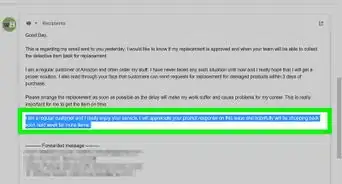

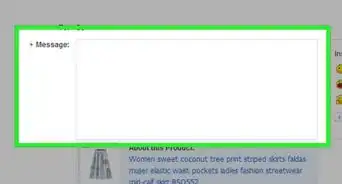

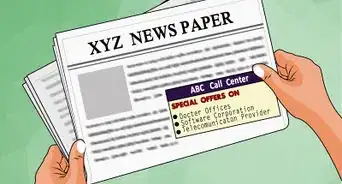







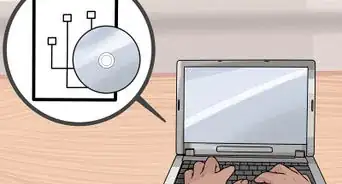

References
- ↑ http://info.microsoft.com/rs/157-GQE-382/images/EN-CNTNT-Report-DynService-2017-global-state-customer-service-en-au.pdf
- ↑ https://www.superoffice.com/blog/customer-service-queues/
- ↑ https://smallbiztrends.com/2018/07/real-time-response-to-customers.html
- ↑ https://smallbiztrends.com/2018/07/real-time-response-to-customers.html
- ↑ https://www.retaildive.com/news/70-of-consumers-still-want-human-interaction-versus-bots/543324/
- ↑ https://www.cio.com/article/2891850/11-tips-for-improving-your-company-s-customer-support.html
- ↑ https://www.consumerreports.org/customer-service/got-bad-customer-service-how-to-complain-well-and-get-results/
- ↑ Art Lewin. Entrepreneur. Expert Interview. 11 June 2021.
- ↑ https://www.cio.com/article/2891850/11-tips-for-improving-your-company-s-customer-support.html
- ↑ https://hbr.org/2010/07/stop-trying-to-delight-your-customers
- ↑ https://hbr.org/2010/07/stop-trying-to-delight-your-customers
- ↑ https://www.asktelemarketing.com/blog/2018/3/20/the-role-of-self-service-in-customer-service
- ↑ https://hbr.org/2010/07/stop-trying-to-delight-your-customers
- ↑ https://hbr.org/2010/07/stop-trying-to-delight-your-customers
- ↑ https://www.consumerreports.org/customer-service/got-bad-customer-service-how-to-complain-well-and-get-results/
- ↑ https://hbr.org/2010/07/stop-trying-to-delight-your-customers
- ↑ https://www.jstor.org/stable/4165910
- ↑ https://www.wired.com/insights/2013/04/tiered-customer-support-is-dead-and-why-thats-good-for-business/
- ↑ https://www.superoffice.com/blog/customer-service-queues/
- ↑ Art Lewin. Entrepreneur. Expert Interview. 11 June 2021.
- ↑ https://edis.ifas.ufl.edu/publication/hr005
- ↑ https://www.consumerreports.org/customer-service/got-bad-customer-service-how-to-complain-well-and-get-results/
- ↑ Art Lewin. Entrepreneur. Expert Interview. 11 June 2021.
- ↑ https://www.consumerreports.org/customer-service/got-bad-customer-service-how-to-complain-well-and-get-results/
- ↑ https://www.researchgate.net/publication/269831775_Customer_perceptions_of_corporate_responses_to_product_complaints_The_role_of_explanations
- ↑ https://www.jstor.org/stable/4165910
- ↑ https://delighted.com/blog/winning-customer-service-strategy
- ↑ https://business.gov.au/people/customers/manage-customer-complaints
- ↑ https://www.jstor.org/stable/4165910
- ↑ https://www.consumerreports.org/customer-service/got-bad-customer-service-how-to-complain-well-and-get-results/
- ↑ https://www.consumerreports.org/customer-service/got-bad-customer-service-how-to-complain-well-and-get-results/
- ↑ https://www.inc.com/young-entrepreneur-council/17-ways-to-deal-with-unhappy-customers.html
- ↑ https://edis.ifas.ufl.edu/publication/hr005
- ↑ https://hbr.org/2010/07/stop-trying-to-delight-your-customers
- ↑ https://www.jstor.org/stable/4165910
- ↑ https://www.industryweek.com/leadership/companies-executives/article/21936659/five-tips-for-better-demand-planning-and-forecasting
- ↑ https://hbr.org/2018/01/how-customer-service-can-turn-angry-customers-into-loyal-ones
- ↑ https://www.barrelny.com/insights/ecommerce-pre-orders-and-waitlists
- ↑ https://www.industryweek.com/leadership/companies-executives/article/21936659/five-tips-for-better-demand-planning-and-forecasting
- ↑ https://www.jstor.org/stable/4165910
- ↑ https://www.consumerreports.org/customer-service/got-bad-customer-service-how-to-complain-well-and-get-results/
- ↑ https://www.uschamber.com/co/start/startup/conducting-competitive-analysis
About This Article

